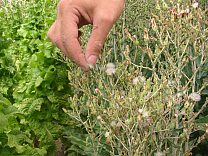Brassica
Sprouting broccoli, cabbages, cauliflowers, kales and brussels sprouts are all members of the same family and will all cross with each other. So you only save seed from one member of the family in any give year and grow as many other brassicas as you like without problems so long as you don't let them flower. Keep at least six plants for seed, ideally more. Remove any poor specimens or any that are not typical for the variety, which you can eat, but don't allow any flowers to open.
All of the brassicas, including cabbages, will throw up a tall flower stalk covered in lots of small yellow flowers. These will then form slender seed pods, which start out green and turn a straw colour as they mature and dry. Once they start to dry, keep a close eye on them as they tend to shatter and drop their seed. Cut out entire plants as the pods begin to look dry and dry thoroughly indoors on a sheet. Once completely dry the pods are easily shattered to release their seeds. The seeds will keep in a cool and dry place for up to four years.Carrots
Carrots are biennial, flowering in their second year of growth. Foliage will die back but will then re-sprout and start to flower in the spring.
Carrots grow into big plants producing successive branches with large flat umbels of flowers.
Dry the seed heads further inside, and then rub them between your hands or in a sieve to separate them. You will notice that the seeds have a 'beard' which is removed in commercial seed to make them easier to pack. You can sieve the seeds further to remove more of the chaff but there is no need to get the seed completely clean, just sow more thickly with the chaff. Carrot seed can be stored in a cool and dark place for up to four years.
Lettuce
 Lettuce flowers are self pollinating and very rarely cross. If you plan to save seed from more than one variety, separate them by around 4 metres or plant a tall crop between the lettuce rows.
Lettuce flowers are self pollinating and very rarely cross. If you plan to save seed from more than one variety, separate them by around 4 metres or plant a tall crop between the lettuce rows. Select two or three good lettuces from your row, and mark them for seed. It is very important not to save seed from any plants that bolt early, as you want to select for lettuces that stand well. Heading lettuces may need a little help for the flowering stalk to emerge; slitting the heads partially open with a knife works well.
Once the lettuces have flowered, the seeds will ripen gradually, starting in about a fortnight. Harvest seed daily to get the maximum yield, shaking into a bag. Or wait until a reasonable number of seeds are ready and then cut the whole plant. Put it head first into a bucket, shaking and rubbing to remove the seeds If you leave the whole cut plant upside down in the bucket somewhere dry, slightly immature seeds will continue to ripen over the next few days.
Most of what you have collected in the bucket will be white 'feathers' and chaff. To sort the seed, shake it gently in a kitchen sieve. Some seeds will fall through the sieve, with the rest collecting in the bottom. The feathers and chaff will rise to the top, and you can pick them off. There's no need to get the seed completely clean; a little chaff stored and planted along with the seeds won't cause any harm.
If the seed feels a little damp, dry it further on a plate before labelling and storing. Lettuce seed should keep for around 3 years, provided it is kept cool and dry.

No comments:
Post a Comment